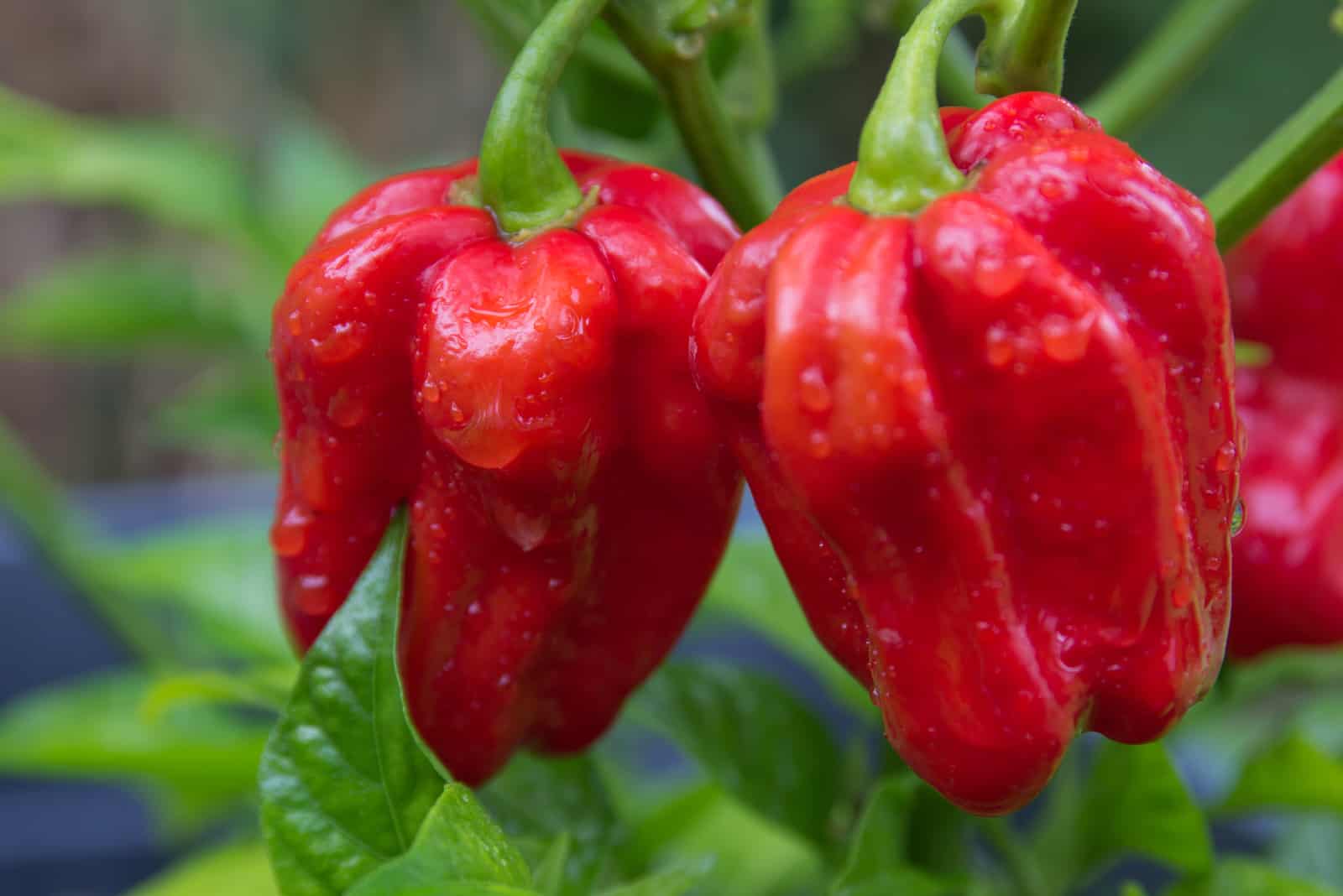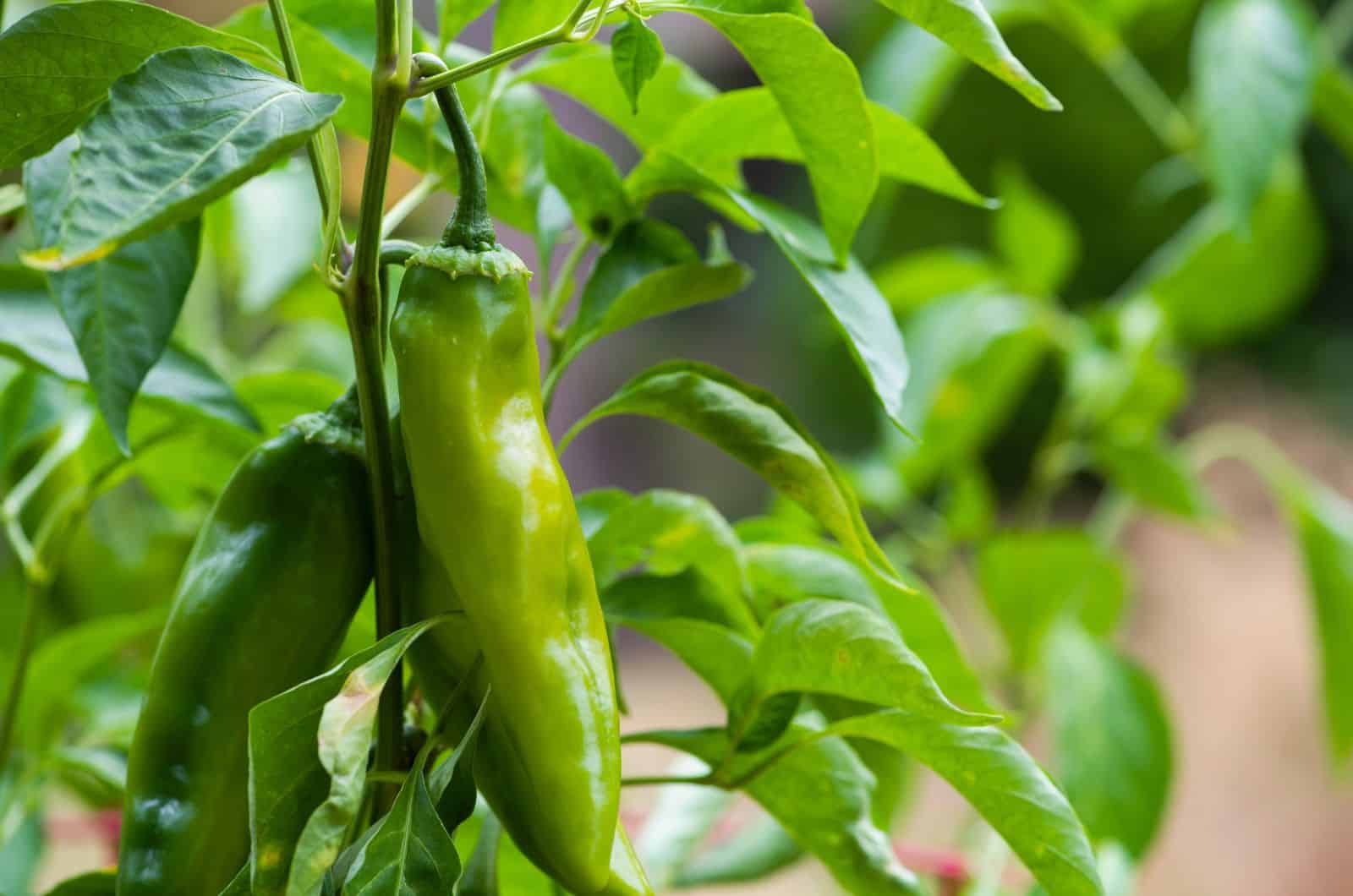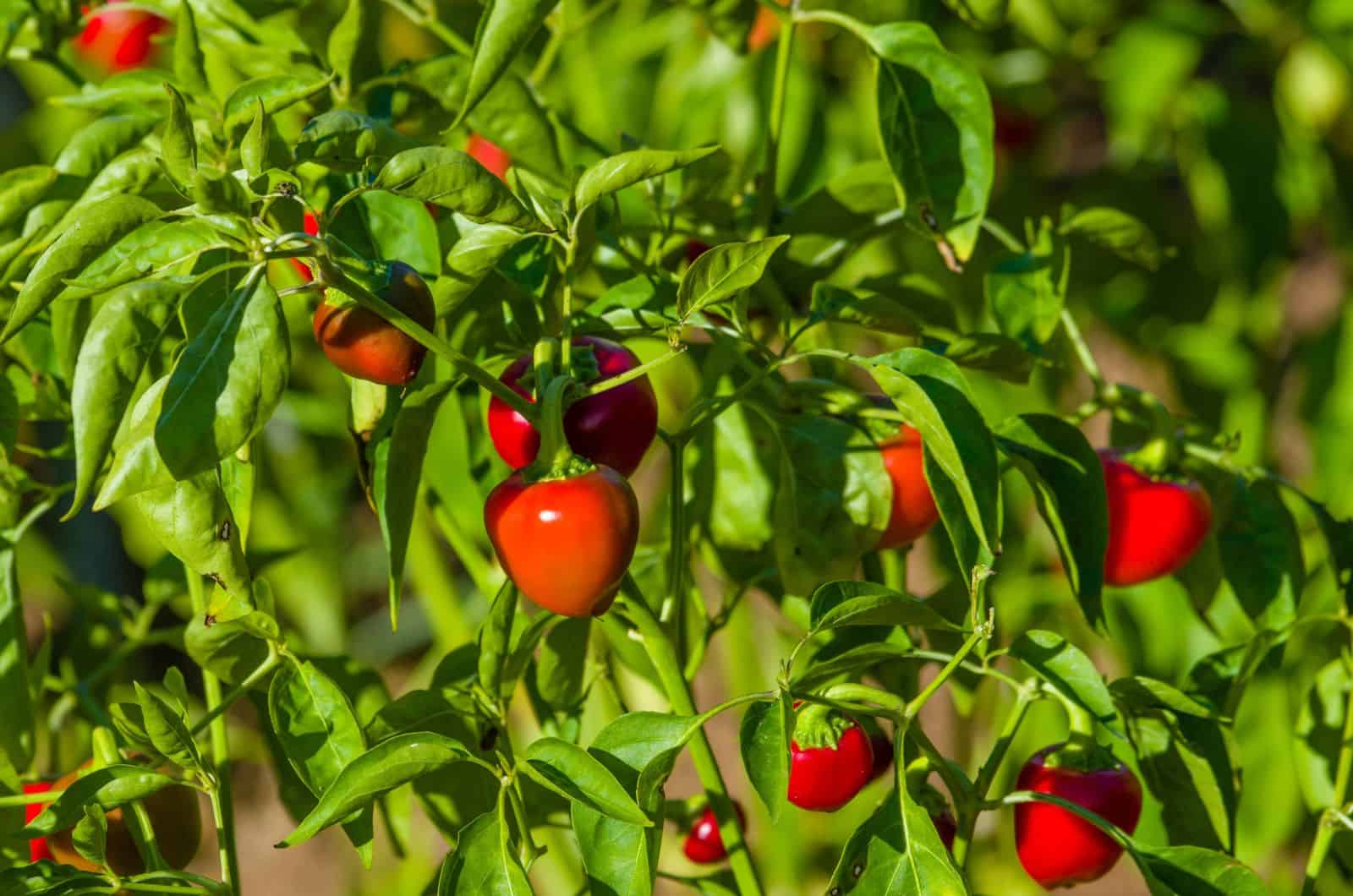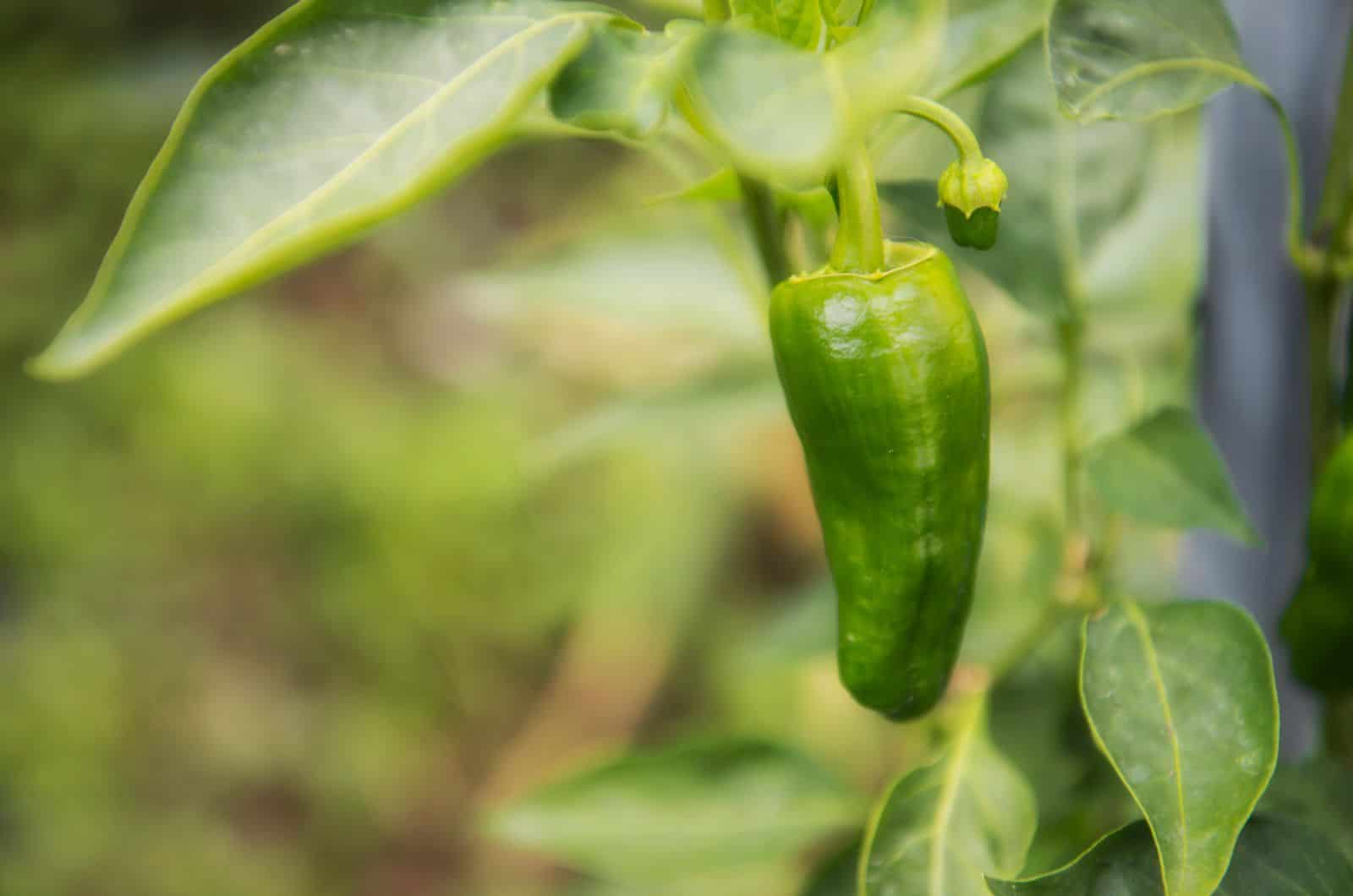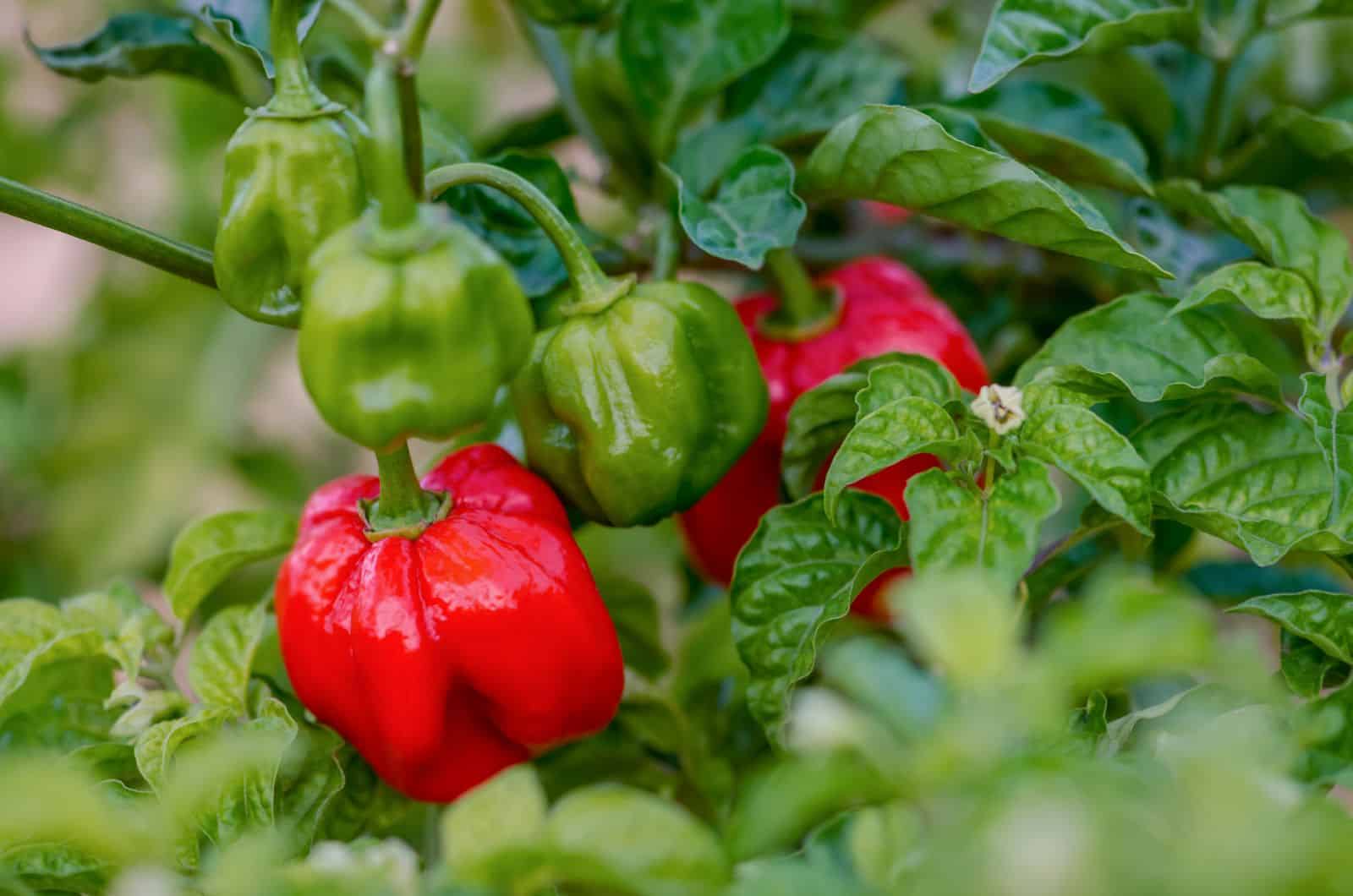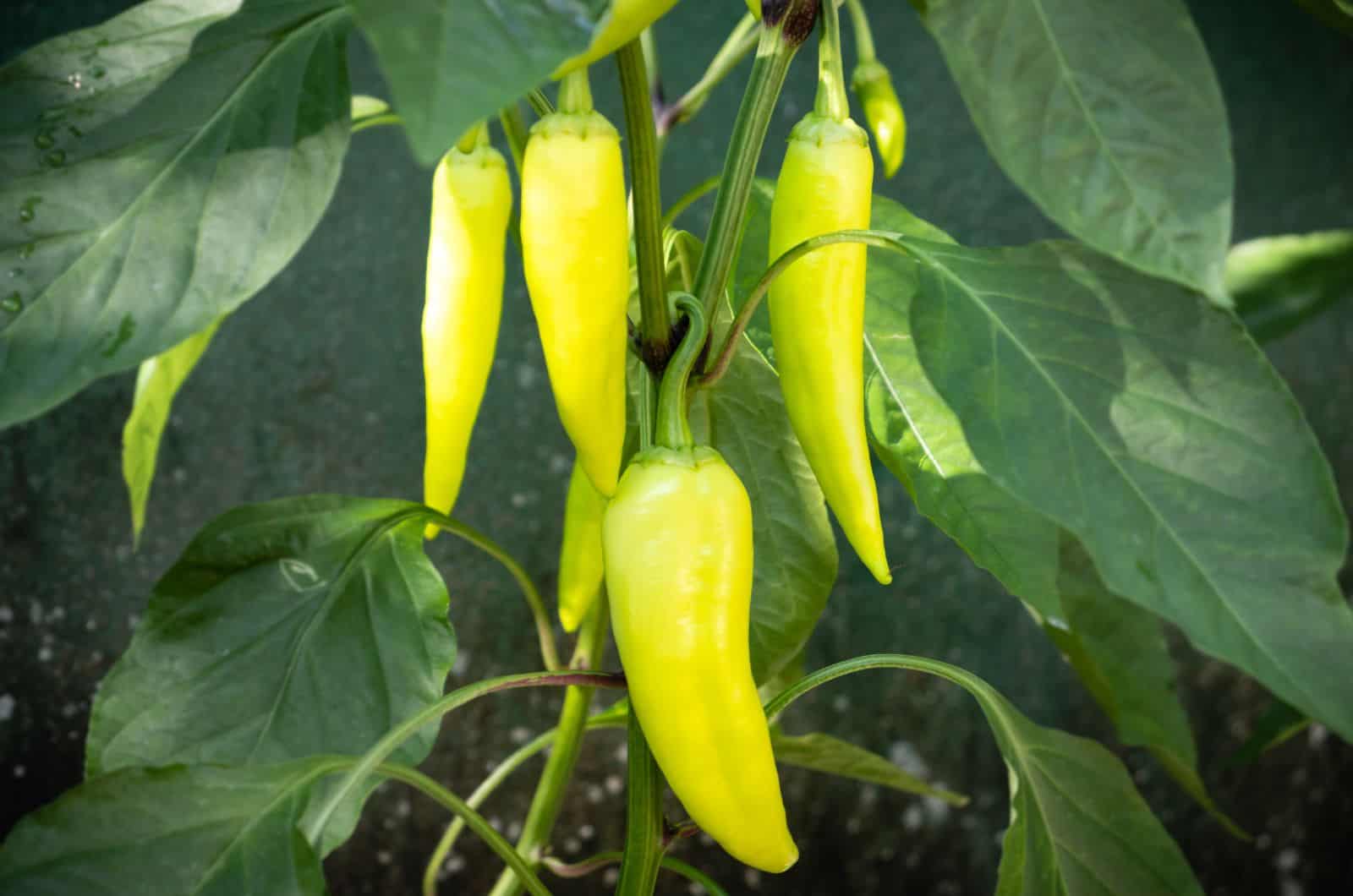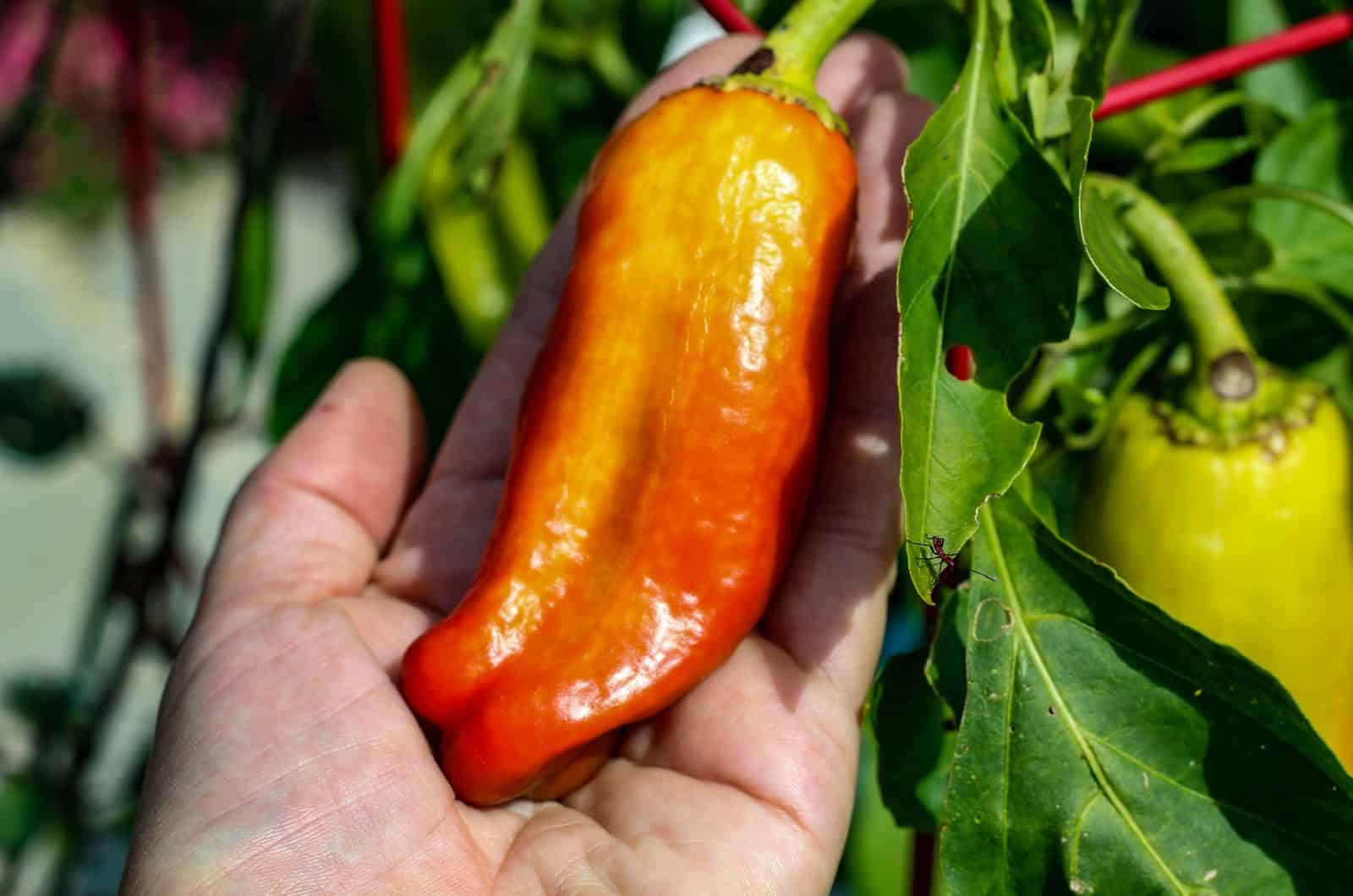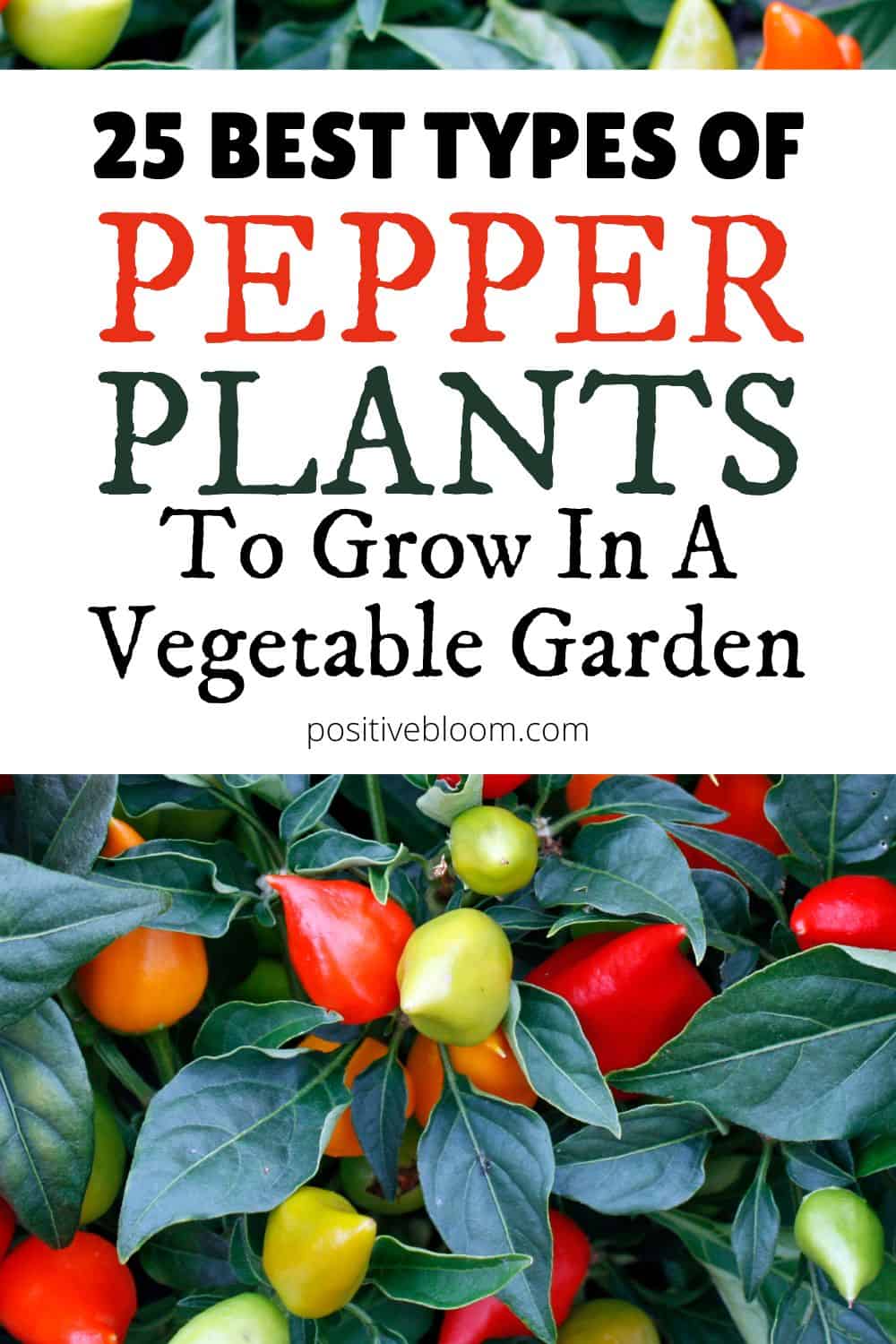To make a prize-winning hot sauce or Mexican Chile Rellenos, you need high-quality peppers. And where can you get better ones than from your own garden?
This article offers 25 different hot and sweet peppers to grow, so you can prepare various dishes from different cuisines.
We’ll discuss their appearance, taste, and the time it takes them to ripen.
We know that it can sometimes be hard to distinguish between sweet and hot peppers, so we’ll also include the main differences that can help you tell them apart.
Let’s get started!
What Are The Main Types Of Pepper Plants?
There are two main categories of peppers: sweet peppers and hot peppers. Sweet peppers usually have 0 Scoville heat units, but some, such as Cubanelle, can tingle your taste buds.
Hot peppers are members of the Capsicum genus that contain a certain dose of heat that ranges from mild to super hot.
Some of the most popular species from this genus are Capsicum annuum, Capsicum frutescens, and Capsicum chinense, but there are other varieties you can experiment with, such as C. pubescens and C. baccatum.
But now, let’s get to the most exciting part of this article: pepper examination!
19 Types Of Chili Peppers
There are many different types of chili peppers (sometimes written as: chile peppers). We’ll discuss nineteen varieties famous for their heat or usage.
Another great thing about spicy peppers is that they come in all colors, shapes, and sizes, so they can make your garden more attractive as well as practical.
But let’s get to the peppers, shall we?
1. Anaheim Pepper
The Anaheim pepper (also called New Mexican or California green chile or chile verde) is one of the milder types as it measures only 500-2,500 SHU.
Most types obtain a green-red hue once ripe, but there are anaheim peppers that can turn entirely red.
But it is its flavor that is the most attractive thing about it; it is sweet and smokey with just the right amount of heat.
Like most peppers, it requires about 80 days for maturation, but it depends on the climate and its growing conditions.
2. Ancho Pepper
The Ancho pepper isn’t that hot and only measures 1,000-1,500 Scoville heat units. It matures to a vivid red color, and it will take about 65-70 days for maturation after the transplant, but you should plant the seeds about eight weeks before moving it outside.
Its mild, smokey, and fruity flavor make it an excellent choice for making various dishes and marinades.
3. Carolina Reaper
The Carolina reaper is the hottest pepper that exists (so far), and its Scoville rating is 1,400,000-2,200 000 SHU!
This pepper is usually red, but there are chocolate brown, bright orange, peach, and yellow varieties to choose from, although all of them are green before they fully ripen.
The Carolina reaper is said to have a fruity and sweet flavor, but once the heat sets in, all that becomes vague. However, it is said to keep some of its aroma despite the heat, which cannot be said for all hot peppers.
It usually takes about 90-100 days to grow this pepper from the seed, but if you want to jump-start your harvest, you can plant the seeds in a container indoors six weeks before the last frost and then transplant them into the ground once the temperatures get warmer.
4. Cayenne Pepper
You can find cayenne pepper in the middle of the Scoville scale, where it reaches 30,000-50,000 SHU.
They are usually red, although some species can be yellow or even purple, making an excellent addition to your vegetable garden.
Cayenne doesn’t have a smoky or earthy note, unlike some other chili peppers. In fact, its fruity flavor turns to heat in your mouth, and that’s about it.
Finally, if you have just planted some cayenne pepper seeds, you’ll be glad to know that it takes about 70-100 days until maturation depending on the growing conditions.
Growers usually pick these peppers when they turn red (or yellow or purple), but you can also harvest them green; they’ll just be less hot!
5. Cherry Peppers
The name of this variety is somewhat misleading as it would make us think that this is actually a sweet pepper. However, the cherry pepper does have some heat (2,500-5,000 SHU).
This variety looks like large cherries (hence the name) and has that classic red pepper color.
The heat and sweetness intertwine in the crisp fruit of the cherry pepper to offer a unique flavor.
It typically takes 60-90 days to grow from seed, but that all depends on the weather conditions.
6. Ghost Pepper
This plant is also known as bhut jolokia, and it takes third place on the Scoville pepper scale, just below the Trinidad scorpion.
It measures between 855,000-1,041,427 SHU, and its sweet chili and fruity flavor cannot beat the heat that it emits.
There are a couple of things that can help you know when to harvest ghost peppers, such as their color and structure.
It usually takes about 5-6 months for them to grow, and you can pick them green if you want less heat. However, if you’re willing to wait a bit longer, you’ll be able to enjoy its various colors, such as peach, red, brown, different shades of yellow, orange, and even white.
7. Habanero Pepper
Habaneros are pretty hot peppers, and if you’d like to experience some of that heat (but still don’t want to cry while doing it), you can always try growing the yellow habanero pepper because they are among the less hot varieties.
Depending on the variety, this species measures between 100,000-350,000 Scoville heat units.
You already know there are yellow habaneros, but you can also find orange, red, brown, green, purple, and even white varieties. The Caribbean Red habanero is a very spicy and uncommon variety.
Many growers choose this Mexico-popular pepper because it is hot, but not too hot. However, flavor plays an essential role. When you taste a habanero, you will feel an explosion of flavors, from sweet to hot and fruity to floral, accentuated by the pepper’s crunchiness.
Finally, hot peppers typically take longer to mature, so it’s not surprising that the habanero takes around 90 days (or longer) to grow from seed to harvest.
8. Jalapeno Pepper
The Jalapeno is also known as chipotle, and it is one of the most famous peppers in the world. It isn’t that hot, but can still add heat to your dishes (2,500-8,000 SHU).
It eventually turns red when ripe, but most growers pick jalapenos as soon as they turn green. These peppers aren’t that hot, so you don’t have to worry whether your friends can handle them.
You can also grow jalapenos in pots, so you won’t have to walk a long way to your garden to pick a couple of these delicious chilis.
They have an earthy and vegetal flavor similar to that of green bell peppers, but unlike sweet bell peppers, jalapenos make your mouth tingle.
Finally, these hot peppers take about 80 days to grow from seed to harvest, but the number may vary depending on the cultivar and weather conditions.
9. Mirasol Chili
The Mirasol chili (also known as guajillo) is a moderately hot pepper that measures 2,500-5,000 SHU on the Scoville scale.
This is another red pepper species, but it can take on different shades of red, from copper to dark red.
The flavor of guajillo is described as berry-like and fruity, and some say that they can even taste a hint of strawberry under the savory chili flavor.
It usually matures within 70-80 days after planting, but that number depends on the weather conditions.
10. Padron Pepper
The Padron is another pepper situated on the lower parts of the Scoville scale, and it measures 500-2,500 SHU.
Most of these peppers are rather mild, so everyone can use them in their everyday cooking.
This Spanish pepper variety is quite small and ripens to a beautiful red color. Although the Padron is usually harvested when still green, so it’s no wonder that most peppers are mild.
The taste buds recognize the flavor of these peppers as nutty and piquant, yet sweet, but the aftertaste can bring a tingle.
The Padron pepper takes about 80-85 days to fully mature, and you can ensure speedy growth by understanding the chili plant growing stages and tending to your pepper plant properly at each phase.
11. Pasilla Pepper
The Pasilla or chilaca pepper is another mild variety with only 500-2,500 SHU.
It is perfect for all sorts of dishes because of its smokey, fruity, and almost earthy flavor, as well as the fact that it isn’t too hot (but you still get that slight tingle in your mouth).
It can also make your vegetable garden less uniform as its deep green and brown color stands out among other veggies.
It typically takes 70-80 days to grow from seed, but it all depends on the weather and the growing conditions.
12. Poblano Pepper
The Poblano is among the mildest hot peppers that exist, and it only measures between 1,000-1,500 SHU.
It is larger than most chili peppers and turns dark green when fully ripe.
The Poblano pepper has almost the same flavor as the green bell pepper, but you can feel a slight tingle from the poblano.
Another thing that many growers love about this pepper, aside from its taste, is the fact that it only takes about 65 days to mature after planting its seeds.
13. Red Fresno Pepper
Red Fresno peppers can emit some real heat, and they usually measure between 2,500-10,000 SHU on the Scoville scale.
As their name suggests, Red Fresnos turn red once they mature, although they are frequently picked when still green because they’re less hot then.
The Fresno pepper does remind us of the jalapeno, but they have a more potent flavor, and you can really taste fruitiness and smokiness.
These peppers don’t take too long to mature and should be ready to harvest 60-90 days after planting the seeds, depending on the growing conditions.
14. Rocoto Pepper
The Rocoto pepper (or aji rocoto) can range between 30,000-100,000 SHU, making them one of the hotter peppers out there.
You can recognize this variety by its black seeds (most peppers have white seeds), while its color is fairly usual (it can be green, yellow, orange, or red).
Their fruity flavor has an underlying note that reminds of tomatoes, wrapped in a unique freshness and grassiness.
To speed up this plant’s growth, you should find the best potting mix for vegetables to plant it in. However, you’ll still have to wait approximately 100-120 days, depending on the climate and growing conditions.
15. Scotch Bonnet
The Scotch Bonnet (aka Caribbean red pepper) shares its place with the habanero on the Scoville scale with 100,000-350,000 SHU.
One of the things growers love about this pepper is that its fruit adds more nuance to their vegetable garden. You can expect the fruit of this plant to be anywhere between green, yellow, orange, red, peach, and deep brown.
An interesting thing about this variety is that its taste can vary based on the soil in which it grows, but it is usually fruity and sweet combined with heat.
It will take 3-4 months to grow this plant from seed, so you will have to wait some time before harvesting it.
16. Serrano Pepper
The Serrano pepper is not the hottest variety, but there are many sweeter peppers than this one, such as jalapenos, Hungarian, poblano, etc.
Still, 10,000-23,000 Scoville heat units are no joke, and you should be careful when cooking with Serrano as it can hurt your eyes.
Just like all other peppers, young serranos are green, but if you leave them to ripen, they can turn yellow, orange, red, or even brown.
Their flavor is similar to that of jalapenos (earthy and vegetal), although these peppers are 2-3 times hotter.
Serranos also take about 80 days to fully ripen, but it depends on the type you decide to grow and the climate in which you grow it.
17. Tabasco Pepper
The tabasco pepper isn’t that hot, in spite of its name. It measures 30,000-50,000 Scoville heat units on the Scoville scale, so it shares its spot with the cayenne pepper.
This particular variety is somewhat small and turns fire-engine red when fully mature.
However, growers don’t usually cultivate it for its interesting color, but for its flavor. The tabasco pepper’s smokey flavor has a unique underlying note and reminds us of tomatoes.
Finally, the plant will be ready to harvest within 80-90 days after planting, depending on the growing conditions.
18. Thai Pepper
The Thai pepper is not as spicy as the habanero, but its 50,000-100,000 SHU still make it a hot pepper.
This variety curls as it matures and never takes on a pure red hue. Instead, ripe Thai peppers are usually a mixture of dark green, reddish, and purplish shades, but there are orange varieties.
The good news is that you can get the seeds of this pepper on Amazon and start growing it today. It tastes a bit like berries, with heat instead of sweetness.
Finally, it takes 60-90 days to grow the Thai pepper from the seed, so if you desperately need some for a specific recipe and can’t find them in the grocery store, you can always cultivate your own.
They will taste much better!
19. Trinidad Scorpion
The second hottest pepper in the world is the Trinidad scorpion, which measures a head-spinning 1,400,000-2,000,000 SHU on the Scoville scale.
It typically matures from green to red, but there are golden-yellow varieties you can grow if you want more color in your vegetable garden.
You might think it’s impossible to taste anything but the heat, but the Trinidad scorpion has an underlying fruity flavor that can’t be resisted.
It takes around 90-120 days for this pepper to fully mature, but you don’t have to stand idle. Plant it a month and a half or two months before the last frost, and transplant it into your garden once the temperatures get warmer.
6 Sweet Pepper Varieties
Don’t think that growing peppers is over for you just because you don’t like the heat of chilis. There are many different sweet pepper varieties out there, and we’ll discuss some of them in the section below.
Some of them can still have some heat, but that’s nothing compared to the chili plants. (I mean, just look at some habanero Scoville ratings – they’ll make your head spin!)
Now, let’s see what sweet peppers you can grow to add some color to your salads and main courses.
1. Banana Peppers
This variety does look like tiny bananas due to their elongated shape and yellow color. However, banana peppers can sometimes lose their yellow color and turn orange, green, or red.
They usually have no heat, but can measure up to 500 SHU on the Scoville scale.
Banana peppers don’t have any particular flavor; they’re simply sweet with a dash of spiciness.
It typically takes them around 75 days to fully ripen after planting. You can pick your banana peppers when they’re 6-8 inches long.
2. Bell Peppers
Bell peppers may be considered true sweet peppers as they don’t have any heat.
And yet, growers around the world decide to grow them due to their richness of color and flavor. For instance, red varieties are the sweetest and have a fruity flavor, with orange and yellow ones shortly behind.
However, green and purple ones have a sort of earthy, slightly bitter flavor.
This sweet species takes 60-90 days to grow, which mainly depends on the growing conditions. Be careful when watering as too much water can cause pepper plant leaves to curl.
3. Cubanelle Pepper
This variety is characterized by its mild heat because it only has 100-500 SHU, but some types are completely sweet and have 0 heat.
The young fruit of this pepper is usually yellow-green, but as it matures, it obtains red shades and can eventually turn vivid red or orange-red.
The flesh of this pepper resembles that of the Anaheim, however, the flavors are somewhat different. The cubanelle has a sweet, honey-like taste and leaves just a slight tingle in your mouth.
This variety takes approximately 70-80 days to grow after sowing the seeds.
4. Pepperoncini
Pepperoncini are also known as Greek, Tuscan, or sweet Italian peppers, and even though they’re considered sweet peppers, they still measure 100-500 SHU on the Scoville scale. However, that’s nothing when compared to the Carolina reaper, ghost peppers, or the Trinidad scorpion.
Pepperoncini are usually yellow to bright green, but they can ripen to a red color.
Their crunchy texture is entangled with a sweet and tangy, almost vinegar-like flavor that can leave a dash of heat. But if you want to reduce the heat even more, you can remove the seeds, as they contain the most capsaicin.
It usually takes 70-75 days to grow this vegetable from seeds.
5. Pimentos
Pimento peppers are incredibly mild and only score 100-500 SHU.
They look like tiny bell peppers, and you can get them in red, green, maroon, or yellow color.
Pimentos taste rather sweet with just a hint of heat that intensifies the flavor and reminds us of red bell peppers; only pimentos are said to be even sweeter!
This variety has an exceptionally long season for sweet peppers, and it takes 80-100 days to grow it from seed.
6. Shishito Pepper
The last pepper we’ll examine in this article is the Shishito pepper. It is very sweet and measures only 50-200 SHU on the Scoville scale.
They are a bright, almost unreal red color when fully ripe, although most growers harvest them when they turn deep green.
Shishito peppers taste smokey and sweet, and you cannot even feel the heat, although it’s technically there.
They take 60-65 days to mature after planting the seeds, which is typical of sweet peppers.
Wrapping Up
This article discussed 25 hot and sweet pepper varieties you can grow in your garden.
They are all more or less hot, smokey, and spicey, which is why we included their Scoville ratings and their general flavor.
However, some of them take longer to mature, so we presented the rough time it would take to grow a specific pepper from seed.
Enjoy the richness of flavor and color with these new peppers, and until next time!
Like this post? Share or pin it for later!

